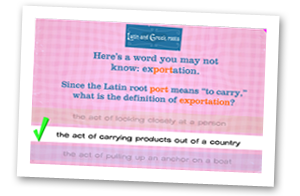Seventh Grade Reading Comprehension Lessons and Standards
A seventh grade reading program should be taught using a system of seventh grade reading lesson plans including interactive activities, learning games, printable worksheets, assessments, and positive reinforcement. Guided reading is also a vital part of a seventh grade reading program.
A good seventh grade reading program relies on many learning tools including reading worksheets, reading activities, reading games, reinforcement exercises, and assessments. Seventh grade language arts lessons should cover all English language arts strands. The major language arts strands for a seventh grade reading program are vocabulary development, reading comprehension, literature, writing strategies, writing applications, English language conventions, listening and speaking. While these language arts strands might surprise you, they are all critical lessons.
Seventh grade reading lesson plans, reading worksheets, and reading activities teach reading skills covering all the language arts strands. Seventh Grade reading lesson plans, reading worksheets, and reading activities teach reading skills covering all the language arts strands. Seventh Grade reading activities provide an opportunity for children to describe and connect essential ideas, arguments, and perspectives by using their knowledge of text structure, organization, and purpose. Seventh Grade reading program students learn through guided reading, reading worksheets, language arts games, and many creative methods that make the Seventh Grade reading program fun for them.
What Are the Seventh Grade Reading Standards and Curriculum?
Time4Learning teaches a comprehensive seventh grade reading curriculum using fun, reading activities to build a solid reading foundation. Help your child excel in reading with Time4Learning’s reading lessons, curriculum, activities and worksheets. Time4Learning’s reading program focuses on vocabulary development, reading comprehension, and literary response.
Vocabulary Development
A seventh grade reading program includes vocabulary and concept development. Reading skills develop as students continue to learn with grade level appropriate reading material. Students learn to describe and connect essential ideas, arguments, and perspectives found in various texts by using a knowledge of text structure, organization, and purpose. They apply this knowledge to achieve fluent oral and silent guided reading skills.
For example, the seventh grade reading program requires students to apply their knowledge of word origins and word relationships, as well as historical and literary context clues, to determine the meaning of specialized vocabulary and to understand the precise meaning of grade level appropriate words. Language arts lesson plans help seventh grade reading skill students identify idioms, analogies, metaphors, and similes in prose and poetry.
The seventh grade reading level also requires them to use knowledge of Greek, Latin, and Anglo-Saxon roots and affixes to understand content-area vocabulary. In seventh grade, students learn to clarify word meanings through the use of definition, example, restatement, or contrast. When reading, they should assess the adequacy, accuracy, and appropriateness of an author’s evidence to support claims and assertions, noting instances of bias and stereotyping.
Reading Comprehension
A seventh grade reading program includes language arts lesson plans that help children learn about the structural features of informational materials. For example, they are expected to understand and analyze differences in structure and purpose between various categories of informational materials including textbooks, newspapers, instructional manuals, and signs. They learn to locate information by using a variety of consumer, workplace, and public documents, and analyze text that uses the cause-and-effect organizational pattern.
The seventh grade reading level is tested with reading comprehension strategies and analysis of reading skill level appropriate text. Students are taught to identify and trace the development of an author’s argument, point of view, or perspective in text. After doing this, they will understand and explain the use of simple mechanical devices by following technical directions.
Literary Response
Seventh grade guided reading includes comprehension and analysis of reading level appropriate text. Seventh grade students learn to analyze a range of responses to a literary work from the reading list or online and determine the extent to which the literary elements in the work shaped those responses. To strengthen seventh grade reading comprehension, students are asked to read and respond to historically or culturally significant works of literature that reflect and enhance their studies of history and social science. Seventh grade language arts lesson plans guide students to demonstrate reading skill by clarifying ideas and connecting them to other literary works. Seventh grade reading program students are expected to demonstrate the reading skill of literary response and structural feature analysis by articulating expressed purposes and characteristics of different forms of prose including short stories, novellas, and essays.
Another vital component of the seventh grade reading program is narrative analysis of reading skill appropriate text. Students identify events that advance the plot and determine how each event explains past or present action(s) or foreshadows future action(s). After guided reading, students are asked to analyze characterization as delineated through a character’s thoughts, words, speech patterns, and actions; the narrator’s description; and the thoughts, words, and actions of other characters. Also in a seventh grade reading program, students develop reading skill by identifying and analyzing recurring themes across works such as the value of bravery, loyalty, and friendship, or the effects of loneliness. Language arts lesson plans for seventh grade students help them contrast points of view, examining first and third person, limited and omniscient, and subjective and objective in narrative text, explaining how they affect the overall theme of the work.
*Reading Standards are defined by each state. Time4Learning bases its use of reading standards on the national bodies that recommend curriculum and standards and the interpretations of it by a sampling of states notably Florida, Texas, and California.











